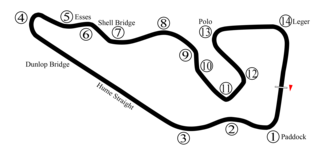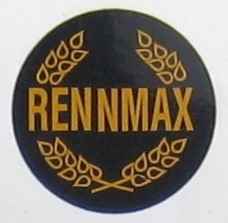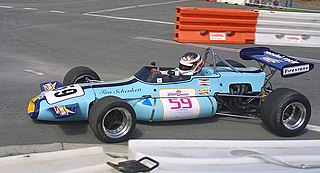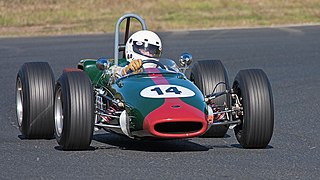Brabham is the common name for Motor Racing Developments Ltd., a British racing car manufacturer and Formula One racing team. Founded in 1960 by Australian driver Jack Brabham and British-Australian designer Ron Tauranac, the team won four Drivers' and two Constructors' World Championships in its 30-year Formula One history. Jack Brabham's 1966 FIA Drivers' Championship remains the only such achievement using a car bearing the driver's own name.

The 1966 Formula One season was the 20th season of FIA Formula One motor racing. It featured the 1966 World Championship of Drivers and the 1966 International Cup for F1 Manufacturers which were contested concurrently over a nine-race series that commenced on 22 May and ended on 23 October. The season also included a number of non-championship races for Formula One cars.

Repco is an Australian automotive engineering/retailer company. Its name is an abbreviation of Replacement Parts Company and it is best known for spare parts and motor accessories.

Silvio Moser was a racing driver from Switzerland.

The Brabham BT19 is a Formula One racing car designed by Ron Tauranac for the British Brabham team. The BT19 competed in the 1966 and 1967 Formula One World Championships and was used by Australian driver Jack Brabham to win his third World Championship in 1966. The BT19, which Brabham referred to as his "Old Nail", was the first car bearing its driver's name to win a World Championship race.

The Repco Brabham BT24 was a Formula One racing car design. It was one of three cars used by the Brabham racing team during their championship-winning 1967 Formula One season. Only three BT24 chassis were ever raced.

Warwick Farm Raceway was a motor racing facility which was in operation from 1960 to 1973. Warwick Farm Raceway hosted numerous major events during its life such as the Australian Grand Prix and rounds of both the Australian Touring Car Championship and the Tasman Series.

The Rennmax name was applied to a series of open wheel racing cars and sports racing cars constructed by Rennmax Engineering in Sydney, Australia between 1962 and 1978. Rennmax Engineering was established by Bob Britton in 1961, its name derived from the German word "Renn", meaning race and the abbreviation "max", for maximum.

The Brabham BT36 was an open-wheel Formula 2 race car, designed by Ron Tauranac, and developed and built by British racing team and constructor, Brabham, for the 1971 European Formula Two Championship. Its best result that season was a 2nd-place finish in the championship for Argentine Carlos Reutemann, despite only winning one race, taking one pole position. His consistency and pace made up for this, scoring 6 podium finishes, and finishing the season with 40 points. The Brabham BT36 was constructed out of a complex tubular space frame, and was powered by the naturally-aspirated 1.6 L (98 cu in) Ford-FVA Cosworth four-cylinder engine, which produced 220 hp (160 kW), and drove the rear wheels through a 5-speed Hewland F.T.200 manual transmission.

The Brabham BT21 was a open-wheel formula racing car, designed, developed, and built by Brabham in large numbers in 1966 and delivered to private individuals; 110 vehicles were manufactured.

The Brabham BT7 is a Formula One racing car. It was raced by the Brabham Racing Organisation and several privateers from 1963 to 1966. A development of its predecessor, the Brabham BT3, the car proved to be competitive during 1963 and 1964, taking Dan Gurney to two victories. Technical issues prevented the BT7 from scoring better results. The car was equipped with a more reliable Hewland gearbox compared to the Colotti-Francis in the BT3. Malcolm Sayer from Jaguar Cars was consulted to give input for the revised chassis. The slick aerodynamics proved particularly strong at high speed circuits such as Monza or Spa. Its successor, the BT11, was a slightly altered BT7 aimed for customers such as Rob Walker or Jo Siffert.

The Brabham BT11 is a Formula One racing car built in 1964, mainly for use by privateers in grand prix racing, but was also used by the Brabham works team during 1964 and 1965. It was the only competitive car of the period available to privateers, recording eight podium finishes in total. The car's best results came at consecutive events in the United States and Mexico 1965, with Dan Gurney qualifying and finishing second in the latter.

The Brabham BT2 is a open-wheel racing car made by Brabham in 1962.

The Brabham BT18 was an open-wheel formula racing, designed, developed, and built by British constructor Brabham, for both Formula 2 and Formula 3 racing categories, in 1966. The BT designation stood for the surname of both Jack Brabham and Ron Tauranac, the two chief designers.

The Brabham BT14 was an open-wheel mid-engined formula racing car, designed, developed and built by British manufacturer and constructor Brabham, in 1965. A total of 10 models were produced. It was specifically constructed to compete in Formula Libre racing. It competed in motor racing between 1965 and 1968; winning a total of 10 races, scoring 22 podium finishes, and clinching 4 pole positions. It also contested the 1967 European F2 Championship season, competitng in 7 races, but with no success; scoring no wins, pole positons, podium finishes, or scoring any points. It was powered by a naturally-aspirated 1.6 L (98 cu in) Ford twin-cam four-cylinder engine, which droves the rear wheels through a conventional 4-speed manual transmission.

The Brabham BT25 was an open-wheel racing car used in the 1968 and 1969 USAC Championships.

The Brabham BT15 is a mid-engined open-wheel Formula 3 racing car, designed, developed, and built by Brabham between 1965 and 1966. 26 cars were built. It was powered by a naturally aspirated, 997 cc (60.8 cu in), Ford straight-four engine ; which was popular with Formula Ford racing at the time.
The Brabham BT32 was an open-wheel racing car, that competed in the USAC Championship Car racing, between 1970 and 1972 USAC Championships. In that time, it was driven by Jack Brabham, Bud Tingelstad, Johnny Rutherford, LeeRoy Yarbrough, and Swede Savage. It's best result in qualification was third-place, and its best race result was an 7th-place finish, being driven by Bud Tingelstad at the prestigious 1971 Indianapolis 500. It was powered by an 159 cu in (2.61 L) Offenhauser turbocharged four-cylinder engine, developing between 770–820 hp (570–610 kW).

The Brabham BT5, and its evolution, the Brabham BT8, are sports racing cars manufactured and developed by Brabham in 1963 (BT5) and 1964 (BT8), respectively. It won a total of 4 races, and achieved 10 podium finishes.
The McLaren M3 was an open-wheel race car, designed, developed and built by British manufacturer McLaren in 1965. It was used mostly in Formula Libre racing, but was very versatile and competitive, and was also used in other motorsport categories and disciplines, such as hillclimb racing, and sprint car racing. It used no particular engine, but was capable of using ; an Oldsmobile V8, a Ford FE, a Ford Indy V8, a Repco V8, a Maserati V12, or even a 2.5–2.7 L (150–160 cu in) Coventry Climax four-cylinder Formula One engine. The chassis was constructed out of a tubular space frame, covered in an aluminum panel body, with extra aluminum riveted and bolted to the undercarriage of the car, to add extra strength and rigidity. This meant weight was around (approximately) 1,100 lb (500 kg).

















